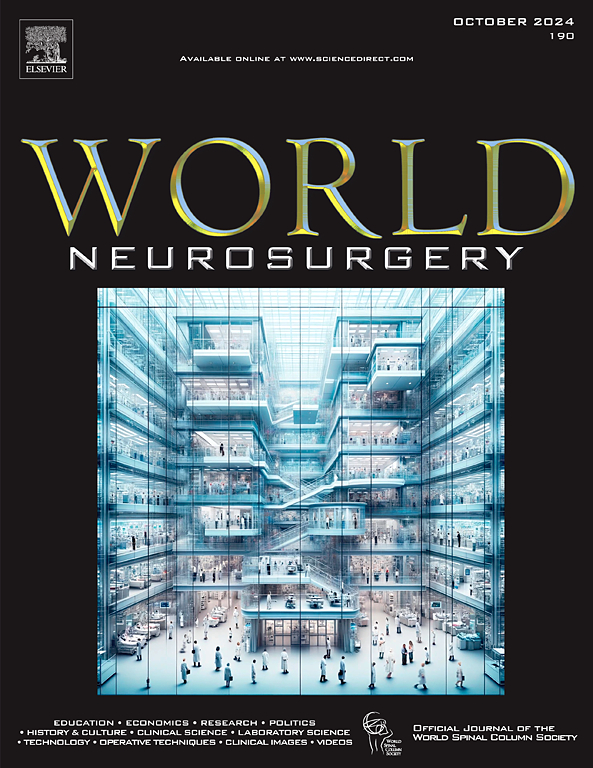Mesenchymal-Type Genetic Mutations Are Likely Prerequisite for Glioblastoma Multiforme to Metastasize Outside the Central Nervous System: An Original Case Series and Systematic Review of the Literature
IF 1.9
4区 医学
Q3 CLINICAL NEUROLOGY
引用次数: 0
Abstract
Background
Glioblastoma multiforme (GBM) is the most aggressive and prevalent type of malignant brain tumor, yet it metastasizes outside the central nervous system (CNS) in only 0.4% of cases. Little is known about what enables this subset of GBMs to take root outside the CNS, but genetic mutations likely play a role.
Methods
We conducted a PRISMA-compliant systematic review of metastatic GBM wherein we reviewed 3579 search results and 1080 abstracts, analyzing data from 139 studies and 211 unique patients. In addition, we describe 4 cases of patients with pathologically confirmed GBM metastases outside the CNS treated at our institution.
Results
We found that metastases were discovered near previous surgical sites in at least 36.9% of cases. Other sites of metastasis included bone (47.9%), lung (25.6%), lymph nodes (25.1%), scalp (19.2%), and liver (14.2%). On average, metastases were diagnosed 12.1 months after the most recent resection, and the mean survival from discovery was 5.7 months. In our patients, primary GBM lesions showed mutations in NF1, TERT, TP53, CDK4, and RB1/PTEN genes. Unique to the metastatic lesions were amplifications in genes such as p53 and PDGFRA/KIT, as well as increased vimentin and Ki-67 expression.
Conclusions
There is strong evidence that GBMs acquire novel mutations to survive outside the CNS. In some cases, tumor cells likely mutate after seeding scalp tissue during surgery, and in others, they mutate and spread without surgery. Future studies and genetic profiling of primary and metastatic lesions may help uncover the mechanisms of spread.
间质型基因突变可能是多形性胶质母细胞瘤向中枢神经系统外转移的先决条件:原始病例系列和文献系统回顾。
背景:多形性胶质母细胞瘤(GBM)是侵袭性最强、发病率最高的恶性脑肿瘤,但在所有病例中,只有0.4%的GBM会转移到中枢神经系统(CNS)以外。人们对是什么原因让这部分 GBM 在中枢神经系统外生根发芽知之甚少,但基因突变可能在其中发挥了作用:我们对转移性 GBM 进行了符合 PRISMA 标准的系统性综述,其中我们查阅了 3579 条搜索结果和 1080 篇摘要,最终分析了来自 139 项研究和 211 名患者的数据。此外,我们还描述了四例在本院接受治疗的病理证实为中枢神经系统外转移的 GBM 患者:我们发现,至少有 36.9% 的病例是在之前的手术部位附近发现转移灶的。其他转移部位包括骨(47.9%)、肺(25.6%)、淋巴结(25.1%)、头皮(19.2%)和肝脏(14.2%)。平均而言,转移灶是在最近一次切除手术后 12.1 个月才被确诊的,发现后的平均存活期为 5.7 个月。在我们的患者中,原发性 GBM 病变显示 NF1、TERT、TP53、CDK4 和 RB1/PTEN 基因突变。转移病灶的独特之处在于p53和PDGFRA/KIT等基因的扩增,以及波形蛋白和Ki-67表达的增加:总之,有确凿证据表明,GBM 可通过获得新的突变在中枢神经系统外存活。在某些病例中,肿瘤细胞可能是在手术过程中播种头皮组织后发生突变,而在另一些病例中,肿瘤细胞则是在未进行手术的情况下发生突变并扩散。未来的研究以及对原发和转移病灶的基因分析可能有助于揭示扩散机制。
本文章由计算机程序翻译,如有差异,请以英文原文为准。
求助全文
约1分钟内获得全文
求助全文
来源期刊

World neurosurgery
CLINICAL NEUROLOGY-SURGERY
CiteScore
3.90
自引率
15.00%
发文量
1765
审稿时长
47 days
期刊介绍:
World Neurosurgery has an open access mirror journal World Neurosurgery: X, sharing the same aims and scope, editorial team, submission system and rigorous peer review.
The journal''s mission is to:
-To provide a first-class international forum and a 2-way conduit for dialogue that is relevant to neurosurgeons and providers who care for neurosurgery patients. The categories of the exchanged information include clinical and basic science, as well as global information that provide social, political, educational, economic, cultural or societal insights and knowledge that are of significance and relevance to worldwide neurosurgery patient care.
-To act as a primary intellectual catalyst for the stimulation of creativity, the creation of new knowledge, and the enhancement of quality neurosurgical care worldwide.
-To provide a forum for communication that enriches the lives of all neurosurgeons and their colleagues; and, in so doing, enriches the lives of their patients.
Topics to be addressed in World Neurosurgery include: EDUCATION, ECONOMICS, RESEARCH, POLITICS, HISTORY, CULTURE, CLINICAL SCIENCE, LABORATORY SCIENCE, TECHNOLOGY, OPERATIVE TECHNIQUES, CLINICAL IMAGES, VIDEOS
 求助内容:
求助内容: 应助结果提醒方式:
应助结果提醒方式:


